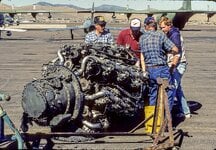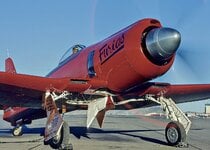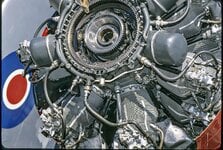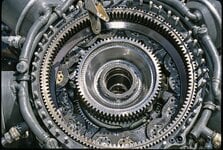Years ago, I posted on a gearhead site about the giant gasoline engines of WWII and got very little response. I've been thinking about this subject again.
WWII was the real last hurrah of giant gasoline engines. They didn't completely disappear for a while afterwards, but the handwriting was on the wall. It's kind of interesting that the USSR and Japan had diesel operated tanks, while in the west, diesel was mostly (but not completely) ignored.
For me, one of the standouts is the Hall-Scott 400/440 which were 1091 cubic inches and powered the M25/26 Tank Transporter. 240 hp at 2100 RPM. 930 ft. lbs of torque at 1350 rpm. These figures were like the figures that diesels of the future would make, but not contemporary diesels. Of course the tradeoff in the M25/26 was approx 1 mpg under ideal conditions, and considerably less when hauling a load. These engines also found use after the war in big trucks.
Another, of course, is the R-4360 Wasp Major, an absolute beast at 4362.5 cubic inches or 71.5l, and up to 4300 hp. Of course it used prodigious quantities of gasoline, and paid for its power with a nightmarish maintenance schedule that made it impractical when Uncle Sam wasn't paying the bills.
The Hall-Scotts have the reputation of being solid, reliable, durable engines. The R-4360, not so much.
And tank engines. The Ford GAA, making 450 or 500 gross horsepower depending on whose figures you're looking at, from 1100 ci, or 18l, with dual overhead cams and over 1000 ft. lbs of torque from idle to 2200 rpm. The Rolls Royce Meteor, with 550+ hp from 27 liters of displacement/1649 cid, with 1350 ft. lbs of torque. Max 2250 rpm. Being a de-rated non-supercharged Merlin (basically, with more cast iron parts), it proved reliable and durable in service. This is the engine that, in the Centurion, made the concept of the MBT feasible. Incidentally, the Australians used Meteor powered Centurions in Vietnam. They had to carry lots of extra gasoline due to this tank being less efficient than a diesel powered M48, for instance. Then, of course, you have the Chrysler A57 Multibank, a 30-cylinder flathead engine that was not quite as diesel-like in its power delivery, but did manage to power a lot of Shermans (mostly palmed off on the Brits). For comparison, the Russian T-34 tank had a 38.8 liter engine producing 500 hp, which doesn't seem like a lot of power from that displacement.
Then there were boat engines. The 83-foot patrol boats used by the USCG had two of the mighty Sterling TCG-8 Viking II engines. These were straight-eights of 3619 cid. Or 59-ish liters. 600 horsepower at 1200 rpm. 5.0:1 compression ratio so they could use whatever crap gasoline was available. And thirsty. At cruising speed, the 83-footers used about 100 gallons per hour, and at full throttle, 120 gph. The US Navy, even though they were working on converting to diesel, used the Hall Scott Defender, a 1996 cid/32.7 liter in the 63 foot rescue boat at 575 horsepower at 2100 rpm.
I find these monster gasoline engines fascinating, until I discovered some of these, I had wondered if there were ever any gasoline engines with diesel-like torque curves. The answer is an emphatic yes. They didn't disappear at the end of WWII, though they slowly gave way to diesels. I remember as a kid in the 60's and early 70's seeing gasoline powered semi-trailer rigs. The weren't that uncommon.
WWII was the real last hurrah of giant gasoline engines. They didn't completely disappear for a while afterwards, but the handwriting was on the wall. It's kind of interesting that the USSR and Japan had diesel operated tanks, while in the west, diesel was mostly (but not completely) ignored.
For me, one of the standouts is the Hall-Scott 400/440 which were 1091 cubic inches and powered the M25/26 Tank Transporter. 240 hp at 2100 RPM. 930 ft. lbs of torque at 1350 rpm. These figures were like the figures that diesels of the future would make, but not contemporary diesels. Of course the tradeoff in the M25/26 was approx 1 mpg under ideal conditions, and considerably less when hauling a load. These engines also found use after the war in big trucks.
Another, of course, is the R-4360 Wasp Major, an absolute beast at 4362.5 cubic inches or 71.5l, and up to 4300 hp. Of course it used prodigious quantities of gasoline, and paid for its power with a nightmarish maintenance schedule that made it impractical when Uncle Sam wasn't paying the bills.
The Hall-Scotts have the reputation of being solid, reliable, durable engines. The R-4360, not so much.
And tank engines. The Ford GAA, making 450 or 500 gross horsepower depending on whose figures you're looking at, from 1100 ci, or 18l, with dual overhead cams and over 1000 ft. lbs of torque from idle to 2200 rpm. The Rolls Royce Meteor, with 550+ hp from 27 liters of displacement/1649 cid, with 1350 ft. lbs of torque. Max 2250 rpm. Being a de-rated non-supercharged Merlin (basically, with more cast iron parts), it proved reliable and durable in service. This is the engine that, in the Centurion, made the concept of the MBT feasible. Incidentally, the Australians used Meteor powered Centurions in Vietnam. They had to carry lots of extra gasoline due to this tank being less efficient than a diesel powered M48, for instance. Then, of course, you have the Chrysler A57 Multibank, a 30-cylinder flathead engine that was not quite as diesel-like in its power delivery, but did manage to power a lot of Shermans (mostly palmed off on the Brits). For comparison, the Russian T-34 tank had a 38.8 liter engine producing 500 hp, which doesn't seem like a lot of power from that displacement.
Then there were boat engines. The 83-foot patrol boats used by the USCG had two of the mighty Sterling TCG-8 Viking II engines. These were straight-eights of 3619 cid. Or 59-ish liters. 600 horsepower at 1200 rpm. 5.0:1 compression ratio so they could use whatever crap gasoline was available. And thirsty. At cruising speed, the 83-footers used about 100 gallons per hour, and at full throttle, 120 gph. The US Navy, even though they were working on converting to diesel, used the Hall Scott Defender, a 1996 cid/32.7 liter in the 63 foot rescue boat at 575 horsepower at 2100 rpm.
I find these monster gasoline engines fascinating, until I discovered some of these, I had wondered if there were ever any gasoline engines with diesel-like torque curves. The answer is an emphatic yes. They didn't disappear at the end of WWII, though they slowly gave way to diesels. I remember as a kid in the 60's and early 70's seeing gasoline powered semi-trailer rigs. The weren't that uncommon.




